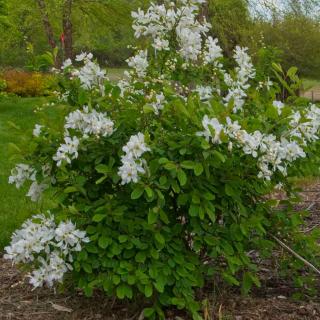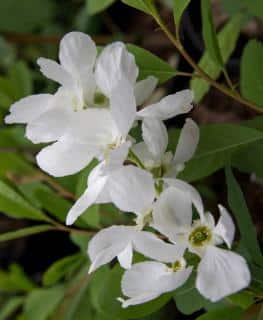

Exochorda is a spectacular flower shrub with abundant white spring blooms.
Exochorda facts, a summary
Name – Exochorda x Macrantha
Family – Rosaceae
Type – shrub
Height – 6 to 10 feet (2 to 3 meters)
Exposure – full sun or part shade
Soil: ordinary, well drained – Foliage: deciduous – Flowering: mid→late spring
Since it is easy to grow and care for, it’s an ideal shrub for a flower bed, and does especially well as part of a flowered hedge and in containers or pots on a terrace.
As for most shrubs, it’s best to plant your Exochorda in fall to favor root development before winter and renewed growth in spring.
However, if purchased in a pot or in a container, you can also plant in spring, taking great care to water more during the first few months, especially in summer.
Exochorda mostly fears excessively chalky soil so be wary of highly alkaline soils.
You can multiply an exochorda plant through sowing in fall or in spring, or through layering in spring and summer.
As for cuttings, although some gardeners have succeeded, it’s known to be quite difficult and results are much less guaranteed than for layering.
Exochorda is a shrub that requires very little work and care all year round.
 The beginning of spring is the best time to prune this shrub.
The beginning of spring is the best time to prune this shrub.
Exochorda doesn’t often fall sick, and apart from the occasional caterpillar, you won’t find any pests on it.
However, it sometimes is finicky when it comes to blooming.
If you have an Exochorda not bearing flowers, there are a few things you can check on:
 Native to Asia, Exochorda is such a wondrous shrub that the common name for it is “Pearl bush” or “Pearlbush”. This is a reference to the white flowers that look as pristine as pearls when just about to open.
Native to Asia, Exochorda is such a wondrous shrub that the common name for it is “Pearl bush” or “Pearlbush”. This is a reference to the white flowers that look as pristine as pearls when just about to open.
All in one ornamental, abundantly flower-bearing and easy to care for, Exochorda is a shrub that definitely boasts appealing assets. Slowly but surely, it is winning over the heart of many gardeners.
Exochorda holds well both to drought and cold, since it’s hardy down to 5°F (-15°C).
A few varieties exist that are beautiful. They differ slightly in terms of shape and foliage density.
Growth is rather slow, which makes it an ideal shrub for smaller gardens.
Is it poisonous to dogs
I planted my Exochorda in a large terracotta pot on the patio. I have watered well regularly, and given miracle grow, so can’t think why I have no flowers !
Hello Valerie, perhaps the following may explain the absence of flowers:
– too much shade : Exochorda does need a bit of sun to bloom. Is your patio covered? More sun, more flowers.
– pruning a bit to early : spring blooming is prepared from end of summer to winter. Perhaps the shrub was trimmed in fall or early spring?
Hopefully your case falls into one of these!